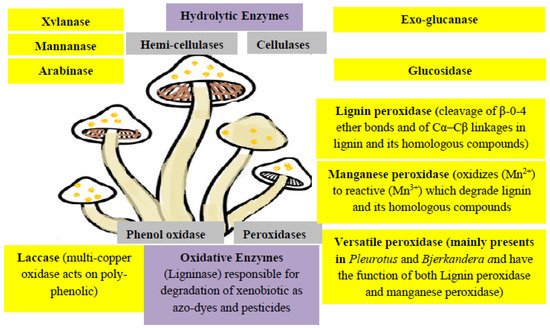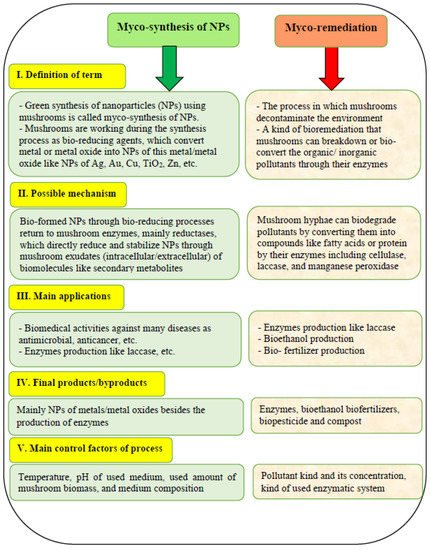Soil pollution is a serious challenge facing the global community. This pollution is a direct and/or indirect harmful deterioration, which penetrates all aspects of our life, especially human health. Therefore, there is an urgent need to repair, remove, or decompose these pollutants according to various approaches. Concerning the relationship between soil nanoremediation and its mushrooms, this process can be called nano myco-remediation. The mechanism of this kind of remediation depends mainly on the enzymatic system of mushroom species and is involved in the bioremediation of organic environmental pollutants.
1. Introduction
Soil pollution is a serious challenge facing the global community. This pollution is a direct and/or indirect harmful deterioration, which penetrates all aspects of our life, especially human health. Therefore, there is an urgent need to repair, remove, or decompose these pollutants according to various approaches. Depending on the kind of pollutants and their concentration in the soil and other environmental compartments, the types of remediation could be selected for bioremediation by microorganisms, phytoremediation by plants, nanoremediation by nanomaterials, nano-bioremediation by both microorganisms and nanomaterials, and nano-phytoremediation by both plants and nanomaterials [
179]. Concerning the nanoremediation of soil, several recent published review articles have discussed this global issue as reported below in this section.
Many traditional materials have applications in soil and water remediation, but many advanced materials could be used, such as nanomaterials, particularly nano-zero valent iron, which can be applied to soil and water polluted with heavy metals [
180,
181]. Different nanoremediation strategies could be used to treat polluted soil, water, and air, including both in situ and ex situ strategies. Several nanoparticles (NPs) could be applied to diminish environmental hazards from pollutants such as TiO
2-NPs, Fe-based NPs, and nanomaterials of silica and carbon [
182]. Concerning these strategies, in situ strategies could be remediated using many approaches such as phytoremediation, bio-slurping, bioventing, bio-sparging, and permeable reactive barrier, whereas ex situ strategies may include bio-pile, bioreactors, windrows, and land farming [
182].
In general, global polluted soils with toxic elements require three important points for their remediation strategies, including (1) using geographical coordinate maps, (2) using suitable soil indices for investigating soil quality, and (3) collecting data on polluted soils, which is crucial for choosing the best treatment strategy, including nanomaterials and others [
6]. The accumulation of organic pollutants on coastal soils and their sediments due to the rapid growth in both population and economy in these areas is considered a serious environmental issue. These organic pollutants, such as polycyclic aromatic hydrocarbons (PAHs), could be remediated using many strategies including chemical oxidation, physical repair, bioremediation, and integrated approaches such as reversible surfactants, micro-nano bubble, and biochar [
183]. Using nano-biochar in remediating polluted soils with heavy metals is a promising approach due to their unique properties for soil remediation, which include a high specific surface area and hydrodynamic dispersivity. The main mechanism of nano-biochar may include high efficacy for the immobilization of non-degradable heavy-metal pollutants in soil rhizosphere [
184].
The reuse of soil polluted for agricultural production after its remediation from petroleum hydrocarbons could be achieved using physical, chemical, and biological methods, bio-electrochemical system, and nanomaterials like biogenic iron oxide depending on the internal and external factors [
185]. Many approaches could be applied for remediating soil from textile mill effluents, which may include dyes, metal pollutants, and organic pollutants from printing, softening, and heat stabilizing. These approaches may include biosurfactants derived from microorganisms, oxidation–reduction, electrokinetic processes, phytoremediation, and nanoremediation using nano-zero valence iron oxide [
186].
2. Soil Nanoremediation and Mushrooms
Concerning the relationship between soil nanoremediation and its mushrooms, this process can be called nano myco-remediation. The mechanism of this kind of remediation depends mainly on the enzymatic system of mushroom species and is involved in the bioremediation of organic environmental pollutants (
Figure 1). Many species of mushrooms have the ability to remediate soil pollutants and could be cultivated in agricultural soil or grown on the compost of crop residues (e.g., animal manure, cobs, straw, and sugarcane bagasse) or agro-industrial wastes such as
Agaricus bisporus, A. subrufescens, Phallus impudicus, Pleurotus ostreatus, and
Volvariella volvacea [
83]. The mechanism mainly depends on the enzymes and their types (e.g., cellulase, laccase, manganese peroxidase, and xylanase). Mushroom hyphae can biodegrade crop residues or wastes by converting them into compounds of carbohydrates, fatty acids, and proteins [
83]. Details of these enzymatic reactions are shown in
Figure 3.
Figure 1. The main enzymatic system in mushroom species responsible for the bioremediation of organic environmental pollutants. Boxes with violet color refer to enzyme category; grey boxes refer to enzyme class while small yellow boxes refer to enzyme name, whereas the big yellow boxes explain the mechanisms of enzymes. Hydrolytic enzymes include hemi-cellulases and cellulases, whereas oxidative enzymes include peroxidases and phenol oxidases, and each enzyme class includes a number of enzymes.
It is worth mentioning that the relationship between mushrooms and nanoparticles (NPs) during the biosynthesis of nanoparticles by mushrooms should be clear and the produced NPs of metals or metal oxides (especially NP-Ag) have been successfully used in different biomedical activities. The main role of mushrooms in this process is as bio-reducing agents. On the other hand, many applications of mushrooms’ spent substrate have been reported, such as removing environmental pollutants in the absence of applied nanomaterials [
187] or in the presence of nanomaterials such as nanoscale ferroferric-oxide-coated biochar derived from wastes of mushroom to remove Cr(VI) [
148]. More studies concerning this approach can be listed in
Table 1, such as [
149,
150,
151] in presence of nanomaterials or [
152,
153,
154,
155,
156] in the absent of nanomaterials.
What is the difference between myco-remediation and green-synthesis of NPs by mushrooms? A brief answer is found in
Figure 2, and more details are given in the following section. Soil myco-remediation or bioremediation is considered an innovative and emerging practice, which shows crucial potential as an effective approach in using natural processes to remove pollutants from soil systems [
83]. The bioremediation of pollutants using mushrooms is presented in
Table 1 under different conditions including the presence/absence of nanomaterials. It could use mushrooms in live or dead form in myco-remediation. Soil bioremediation could be achieved using spent mushroom substrate (SMS), which helps in the biodegradation of different pollutants (e.g., heavy metals, pesticides, chlorinated hydrocarbons, polycyclic aromatic hydrocarbons, petroleum, and related products). Many studies have reported the use of spent mushroom substrate in the bioremediation of different polluted environments as green adsorbents, which can remove up to 90% of pollutants from soil [
188] or from groundwater [
189], such as simulated acid mine drainage [
190], biopesticide development [
191], zero waste management [
192], the production of xylo-oligosaccharides as feed ingredient and functional food [
193], and polluted soils [
100,
109,
194,
195]. The SMS also can promote plant disease resistance [
170], whereas the cultivation of mushrooms (like
Agaricus subrufescens) is considered a promising remediator agent under the “circular food-to-waste-to-food system” [
125]. More information about SMS applications and their challenges for “sustainable development of the global mushroom industry” is emphasized in the distinguished review article of Leong et al. [
196] and the book chapter of Rajavata et al. [
197].
Table 1. Some published studies on the nano-bioremediation of polluted environments using fungi (mainly the mushrooms) in the presence and absence of applied nanomaterials.
| Bio-Source |
Applied Material |
Pollutant |
Mechanism or Main Findings |
Refs. |
| I. In presence of nanomaterials |
|
|
| Lentinula edodes |
Biochar nano Fe3O4 (LBC) |
Cr(VI) (200 mg L−1) |
Max. removing rate of Cr(VI) by LBC-Fe3O4 was 99.44% in aqueous media |
[198] |
| Lentinula edodes Agrocybe cylindracea |
Nano Fe3O4 at 2, 4, 6–22, 24 g L−1 |
Cr(VI) at 200 mg L−1 |
Removing Cr(VI) up to 73.88 at 240 min, 40 °C, pH 3 from 200 mg L−1 liquid by combined adsorption and redox |
[199] |
| Saccharomyces cerevisiae (Desm.) Meyen |
Pd-NPs (32 nm) |
Azo dye direct blue 71 |
Pd-NPs degraded 98% of direct blue 71 dye photochemically within 60 min under UV light in an aqueous medium |
[200] |
| Tricholoma crissum Sacc. |
CuO-NPs |
Thorium (Th4+) |
An indicator for detecting Th4+ in aqueous medium |
[201] |
| II. In absent of nanomaterials |
|
|
| Pleurotus ostreatus Pleurotus eryngii |
Fresh SMS at rate of 4:1 (soil: SMS) |
PAHs (2.63 mg kg−1) in soil |
Effective remediating due to activity of laccase and manganese peroxidase in the treatment of fresh P. eryngii SMS |
[81] |
Agaricus bisporus
Pleurotus eryngii |
Soil amended by 5% SMS (w/w) |
Total Cd in soil 72.87 mg kg−1 |
Applied SMS of both mushrooms improved rice production by 38.8%; decreased Cd in soil by about 99% |
[100] |
| Pleurotus ostreatus |
Soil amended by dried SMS (3–12 g kg−1) |
Soil Co was 8.53 mg kg−1 |
Maximum pakchoi biomass recorded at applied SMS up to 9.51 g kg−1 and Co phytoavailability in soil was minimum |
[111] |
| Mushroom residues |
Soil amended by 10% of residues |
Pb/Zn slag: 3.1 and 4.6 g kg−1, res. |
Mushroom residue enhances phyto-remediation of Paulownia fortunei in Pb-Zn slag; alleviates their toxicity to plants |
[117] |
| Pleurotus ostreatus |
Mine polluted soil mixed with the spawn of P. ostreatus |
Cr and Mn: 1.5 and 8.8 g kg−1, res. |
Studied mushroom is a bio-accumulator of toxic metals (Cr, Mn, Ni, Co) from polluted soil, but not recommended to harvest/eat mushroom from polluted soil |
[202] |
| Auricularia auricular and Sarcomyxa edulis |
SMS mixed with polluted soil |
PAH-polluted soil |
Humic acid and SMS enhanced bioremediation by bacteria through laccase activity via biodegradation |
[195] |
| Ganoderma lucidum, Pleurotus ostreatus, Auricularia polytricha |
SMS (25 g) put into the mold |
Formaldehyde free bio-board |
The produced bio-board material from SMS of G. lucidum recorded the highest strength (2.51 mPa); high resistance to both fire and water |
[203] |
| Discarded sticks of mushrooms |
MnO2-modifed biochar |
Antimony, Sb 100 mg L−1 in aqueous solution |
MnO2-modified biochar produced from discarded sticks of mushrooms was excellent adsorbent; adsorption capacity 64.12 mg g−1 |
[204] |
Figure 2. A comparison between myco-remediation and green synthesis of nanoparticles by mushrooms, including the definition of each process, their applications, their control factors, and the final products.
This entry is adapted from the peer-reviewed paper 10.3390/su14074328


